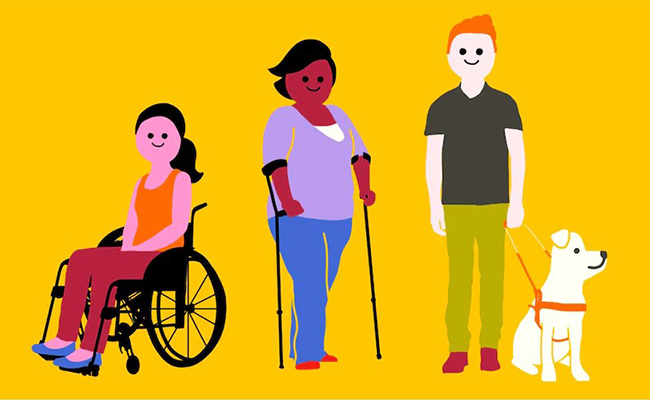Sadly, public health policies and ableism have often gone hand-in-hand. The past two years have given us many examples of this deadly correlation— some of which I will discuss here. Ableism is a form of discrimination you’ve witnessed, yet likely not have recognized while it was happening… even if right in front of your very eyes. It’s a veiled “-ism” shrouded in discomfort and hidden from view. (Read more of my piece on this topic HERE.)
Public health policies are created for expediency, for economic/political reasons, and to keep the public safe, of course. But these goals can often come into direct conflict with one another. For a policy that is easy to administer, that will maximize outcomes for the able-bodied masses, is often not structured to best protect the vulnerable— the elderly, disabled and high-risk.
This is where the unwitting alliance between public health and ableism comes in.
I must start by saying that public health strategies, and public health workers, do their mission with the best of intentions. Their aim is to make a safer and healthier society. That is without doubt. But, within bureaucratic systems, choices are made. Choices on who to prioritize, and who not to prioritize. Within these choices, biases and “-isms” always emerge.
Historically, one of earliest relics of ableism in our public health system is the creation of the system of segregation and institutionalization of the disabled. While pursued under the moral guise of protecting the disabled and providing care, the institutionalization of the disabled fundamentally served a different purpose. The main goal? To alleviate the “burdens” of these individuals on society at-large. By segregating these groups away, the able-bodied were believed to have better, easier and more productive lives. And that was the priority for a growing, changing, and industrializing world that valued productivity above all else.
While layers have been stripped away from the system of institutionalization over the years (with the focus slowing shifting to home-and-community-based services), the foundation of this system remains today.
There is still a preference for institutionalization baked into most medical insurance plans (public and private). While there can be coverage for institutional care, there isn’t the same coverage if you wish to seek homecare. Ironically, homecare is far more economical than institutional care— which is further evidence that efficiency and economics weren’t a main consideration when the entire institutionalization system was created. (It was about segregation.)
Flashing forward into today, we don’t need to look far to see the implications of ableism on public health policies and decisions. During the early months of the pandemic, as hospitals filled, and resources were stretched, we began to see hospitals employ their “surge protocols.” For the uninitiated, “surge protocol” is a structured parameter/rubric that medical personnel use to decide who gets care and who does not. If a decision must be made on who gets a ventilator, the surge protocol outlines which people are prioritized, and who is left without.
Before the pandemic, surge protocols were rarely utilized. They were always hidden away in some dusty binder in a hospital administration office— or posted online in some random corner of their website. So, the details in these procedures were not really known to everyday people. Even today after living in a pandemic world for over 26 months, many still don’t know what the term means.
Surge protocols include charts and lists of which people are the most worth saving. It forces doctors to put values and numbers on patients they don’t know. Patients who are ranked using all the biases and “-isms” the medical establishment brings to the table.
To those of us in the disability community, we immediately felt the effects of this. When I examined the surge protocols for various medical organizations around the country, I was met with the stark reality that my specific disability put me in the bottom rung. The red level. The “don’t-even-bother-with-her” level. I saw it in black and white on hospital letterhead.
These public health policies are not just hypothetical scenarios— they have been utilized. In June 2020, Michael Hickson, a Black disabled man from Texas, was hospitalized with severe COVID19. Against the wishes of his wife and family, the hospital single-handedly decided to withdraw treatment—leading to his death. Officials at the hospital had decided that Michael’s life was not worth saving— evaluating that his ‘quality of life’ was substandard compared to others. (Read more about this here: https://www.npr.org/2020/07/31/896882268/one-mans-covid-19-death-raises-the-worst-fears-of-many-people-with-disabilities)
This bias has trickled into other aspects of the pandemic response. When the vaccine roll-out began in early 2021, disabled and high-risk groups (despite having the highest mortality rates for COVID19) were not included in the top tiers of access. Rather, public health officials prioritized able-bodied groups that were deemed more valuable. Further, adequate supplies of PPE have also been difficult for disabled folks to get— even though the disabled face daily exposure from caregivers, family, and other support staff.
The communication between public health officials, and the disability community, has been hampered by the stain of ableism, as well. Despite the collaborative efforts made between government officials and various American groups (health workers, seniors, educators, small business interests, etc.), little outreach has been made with disability advocacy groups. (see: https://www.pbs.org/newshour/health/a-disabled-activist-speaks-out-about-feeling-disposable)
While the CDC has attempted to remedy this (see this video meeting between Dr. Rochelle Walensky of the CDC and disability advocates: https://www.youtube.com/watch?v=N6jNTAX89Ns ), there is still a long way to go. Sadly, the recent rollback of public health protocols (motivated by political and economic interests) has put disabled people at increased risk as this pandemic enters a new wave. This will translate into more disabled people dying. It’s truly as simple as that.
I’m left with one question: going forward, can public health officials overcome the impact of the ableism that has been so foundational in the development of their policies?
I honestly don’t know. But let’s have a conversation about it. Please share your stories with us. We want to hear from you.

